Phosphorus Migration and Transformation in Activated Sludge by Ultrasonic Treatment
Abstract
1. Introduction
2. Materials and Methods
2.1. Experimental Set-Up
2.2. Analytical Methods
3. Results and Discussion
3.1. Sludge Disintegration via Ultrasonic Treatment
3.2. Phosphorus Release during Ultrasonic Treatment
3.3. Transformation of Phosphorus Species in Sludge Structure
3.4. Mechanism for P Migration in Activated Sludge by Ultrasonic Treatment
3.4.1. Dissolution Stage
3.4.2. Reprecipitation Stage
3.4.3. Equilibrium Stage
4. Conclusions
Author Contributions
Funding
Institutional Review Board Statement
Informed Consent Statement
Data Availability Statement
Conflicts of Interest
References
- Suh, S.; Yee, S. Phosphorus use-efficiency of agriculture and food system in the US. Chemosphere 2011, 84, 806–813. [Google Scholar] [CrossRef] [PubMed]
- Li, B.; Boiarkina, I.; Young, B.; Yu, W.; Singhal, N. Prediction of Future Phosphate Rock: A Demand Based Model. J. Environ. Inform. 2018, 31, 41–53. [Google Scholar] [CrossRef]
- Cordell, D.; Drangert, J.O.; White, S. The story of phosphorus: Global food security and food for thought. Glob. Environ. Chang. 2009, 19, 292–305. [Google Scholar] [CrossRef]
- Yu, B.H.; Luo, J.H.; Xie, H.H.; Yang, H.; Chen, S.P.; Liu, J.Y.; Zhang, R.N.; Li, Y.Y. Species, fractions, and characterization of phosphorus in sewage sludge: A critical review from the perspective of recovery. Sci. Total Environ. 2021, 786, 147437. [Google Scholar] [CrossRef]
- Yang, G.; Zhang, G.M.; Wang, H.C. Current state of sludge production, management, treatment and disposal in China. Water Res. 2015, 78, 60–73. [Google Scholar] [CrossRef]
- Cooper, J.; Lombardi, R.; Boardman, D.; Carliell-Marquet, C. The future distribution and production of global phosphate rock reserves. Resour. Conserv. Recycl. 2011, 57, 78–86. [Google Scholar] [CrossRef]
- Sheng, G.P.; Yu, H.Q.; Li, X.Y. Extracellular polymeric substances (EPS) of microbial aggregates in biological wastewater treatment systems: A review. Biotechnol. Adv. 2010, 28, 882–894. [Google Scholar] [CrossRef]
- Laspidou, C.S.; Rittmann, B.E. A unified theory for extracellular polymeric substances, soluble microbial products, and active and inert biomass. Water Res. 2002, 36, 2711–2720. [Google Scholar] [CrossRef]
- Nguyen, T.P.; Hankins, N.P.; Hilal, N. A comparative study of the flocculation behaviour and final properties of synthetic and activated sludge in wastewater treatment. Desalination 2007, 204, 277–295. [Google Scholar] [CrossRef]
- Le, N.T.; Julcour-Lebigue, C.; Delmas, H. An executive review of sludge pretreatment by sonication. J. Environ. Sci. 2015, 37, 139–153. [Google Scholar] [CrossRef]
- Tyagi, V.K.; Lo, S.L.; Appels, L.; Dewil, R. Ultrasonic Treatment of Waste Sludge: A Review on Mechanisms and Applications. Crit. Rev. Environ. Sci. Technol. 2014, 44, 1220–1288. [Google Scholar] [CrossRef]
- Khanal, S.K.; Grewell, D.; Sung, S.; Van Leeuwen, J. Ultrasound applications in wastewater sludge pretreatment: A review. Crit. Rev. Environ. Sci. Technol. 2007, 37, 277–313. [Google Scholar] [CrossRef]
- Kim, J.; Park, C.; Kim, T.H.; Lee, M.; Kim, S.; Kim, S.W.; Lee, J. Effects of various pretreatments for enhanced anaerobic digestion with waste activated sludge. J. Biosci. Bioeng. 2003, 95, 271–275. [Google Scholar] [CrossRef]
- Gong, C.X.; Jiang, J.G.; Li, D.A. Ultrasound coupled with Fenton oxidation pre-treatment of sludge to release organic carbon, nitrogen and phosphorus. Sci. Total Environ. 2015, 532, 495–500. [Google Scholar] [CrossRef] [PubMed]
- Chu, C.P.; Chang, B.V.; Liao, G.S.; Jean, D.S.; Lee, D.J. Observations on changes in ultrasonically treated waste-activated sludge. Water Res. 2001, 35, 1038–1046. [Google Scholar] [CrossRef]
- Xiao, K.K.; Chen, Y.; Jiang, X.; Tyagi, V.K.; Zhou, Y. Characterization of key organic compounds affecting sludge dewaterability during ultrasonication and acidification treatments. Water Res. 2016, 105, 470–478. [Google Scholar] [CrossRef]
- Liu, J.Q.; Deng, S.Y.; Qiu, B.; Shang, Y.; Tian, J.B.; Bashir, A.; Cheng, X. Comparison of pretreatment methods for phosphorus release from waste activated sludge. Chem. Eng. J. 2019, 368, 754–763. [Google Scholar] [CrossRef]
- Dominguez, L.; Rodriguez, M.; Prats, D. Effect of different extraction methods on bound EPS from MBR sludges Part II: Influence of extraction methods over molecular weight distribution. Desalination 2010, 262, 106–109. [Google Scholar] [CrossRef]
- Garcia-Albacete, M.; Martin, A.; Cartagena, M.C. Fractionation of phosphorus biowastes: Characterisation and environmental risk. Waste Manag. 2012, 32, 1061–1068. [Google Scholar] [CrossRef]
- Pardo, P.; Lopez-Sanchez, J.F.; Rauret, G. Relationships between phosphorus fractionation and major components in sediments using the SMT harmonised extraction procedure. Anal. Bioanal. Chem. 2003, 376, 248–254. [Google Scholar] [CrossRef]
- Xie, C.S.; Zhao, J.; Tang, J.; Xu, J.A.; Lin, X.Y.; Xu, X.H. The phosphorus fractions and alkaline phosphatase activities in sludge. Bioresour. Technol. 2011, 102, 2455–2461. [Google Scholar] [CrossRef] [PubMed]
- Muller, J. Disintegration as a key-step in sewage sludge treatment. Water Sci. Technol. 2000, 41, 123–130. [Google Scholar] [CrossRef]
- Bougrier, C.; Carrere, H.; Delgenes, J.P. Solubilisation of waste-activated sludge by ultrasonic treatment. Chem. Eng. J. 2005, 106, 163–169. [Google Scholar] [CrossRef]
- Erden, G.; Filibeli, A. Ultrasonic pre-treatment of biological sludge: Consequences for disintegration, anaerobic biodegradability, and filterability. J. Chem. Technol. Biot. 2010, 85, 145–150. [Google Scholar] [CrossRef]
- Kidak, R.; Wilhelm, A.M.; Delmas, H. Effect of process parameters on the energy requirement in ultrasonical treatment of waste sludge. Chem. Eng. Process. 2009, 48, 1346–1352. [Google Scholar] [CrossRef]
- He, Z.W.; Liu, W.Z.; Wang, L.; Yang, C.X.; Guo, Z.C.; Zhou, A.J.; Liu, J.Y.; Wang, A.J. Role of extracellular polymeric substances in enhancement of phosphorus release from waste activated sludge by rhamnolipid addition. Bioresour. Technol. 2016, 202, 59–66. [Google Scholar] [CrossRef]
- Liu, Z.G.; Zhou, S.Q.; Dai, L.L.; Dai, X.H. The transformation of phosphorus fractions in high-solid sludge by anaerobic digestion combined with the high temperature thermal hydrolysis process. Bioresour. Technol. 2020, 309, 123314. [Google Scholar] [CrossRef]
- Mayer, B.K.; Baker, L.A.; Boyer, T.H.; Drechsel, P.; Gifford, M.; Hanjra, M.A.; Parameswaran, P.; Stoltzfus, J.; Westerhoff, P.; Rittmann, B.E. Total Value of Phosphorus Recovery. Environ. Sci. Technol. 2016, 50, 6606–6620. [Google Scholar] [CrossRef]
- Wolski, P.; Zawieja, I. Effect of Ultrasound Field on Dewatering of Sewage Sludge. Arch. Environ. Prot. 2012, 38, 25–31. [Google Scholar] [CrossRef][Green Version]
- Wilfert, P.; Kumar, P.S.; Korving, L.; Witkamp, G.J.; van Loosdrecht, M.C.M. The Relevance of Phosphorus and Iron Chemistry to the Recovery of Phosphorus from Wastewater: A Review. Environ. Sci. Technol. 2015, 49, 9400–9414. [Google Scholar] [CrossRef]
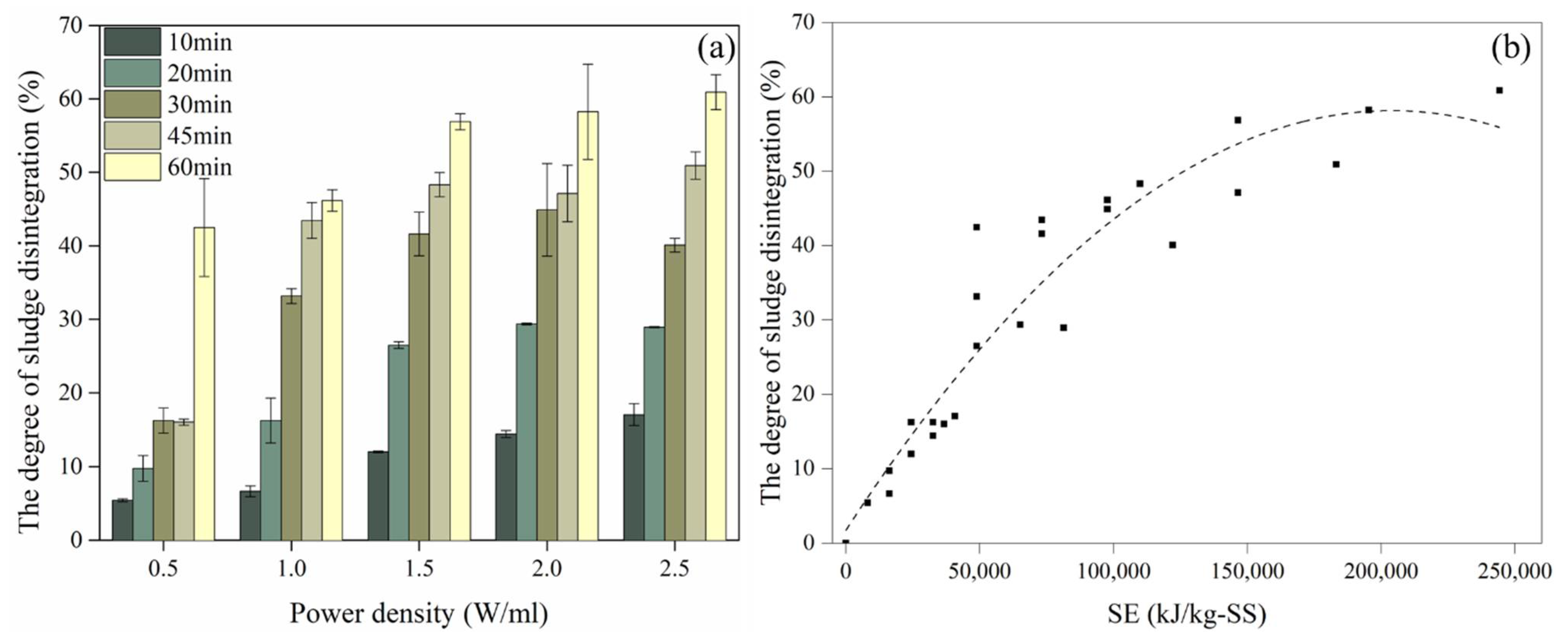
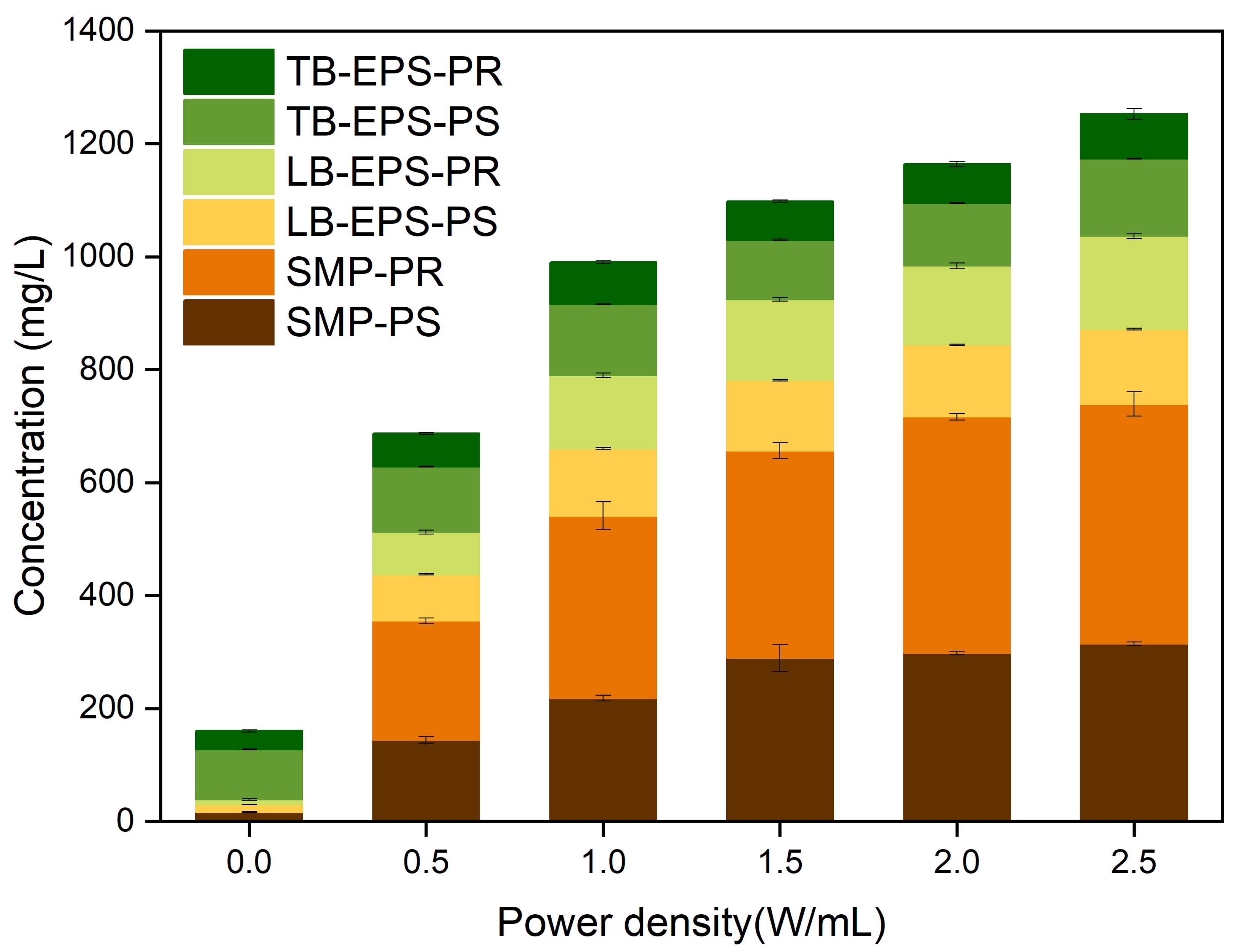
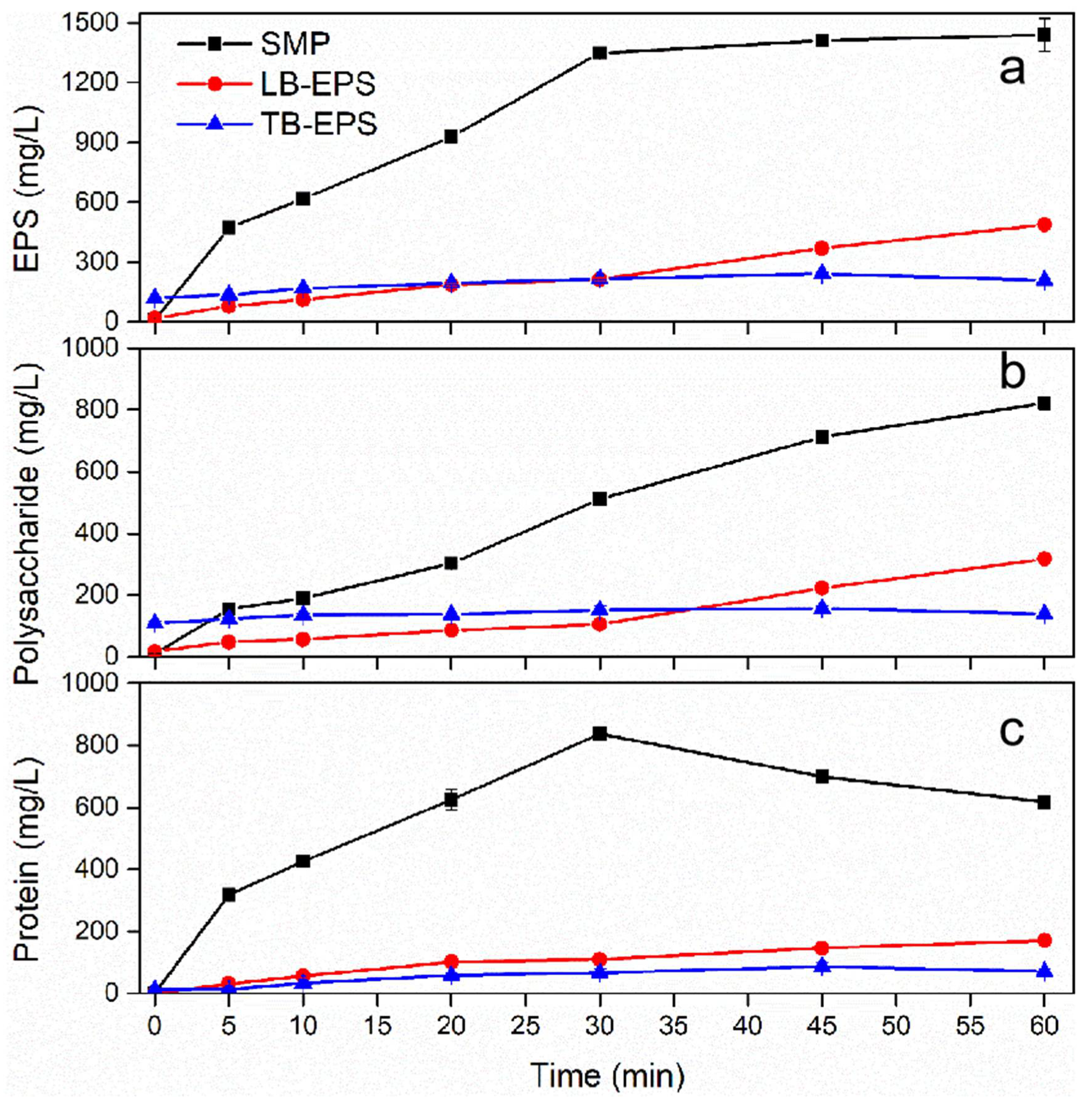
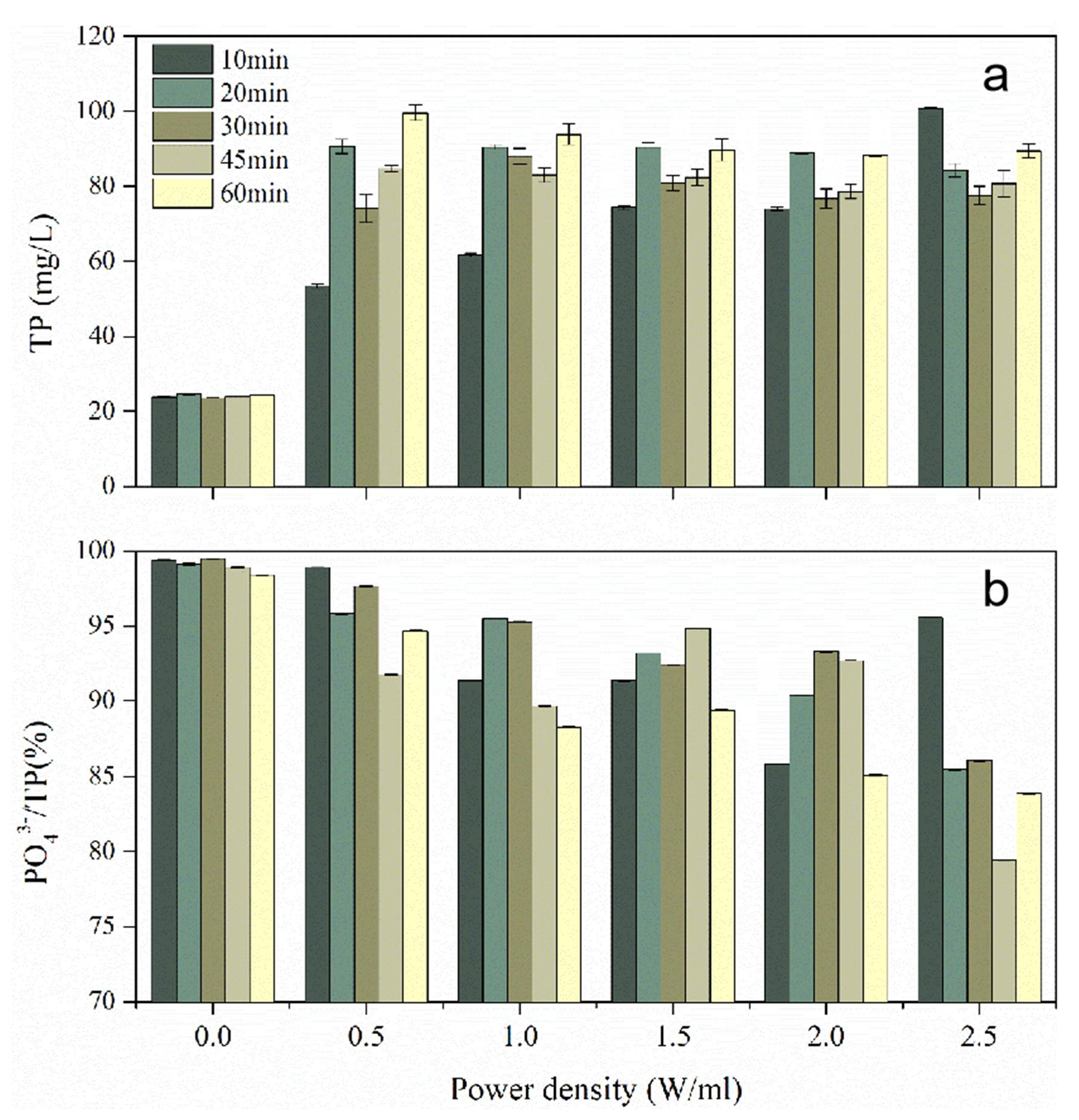
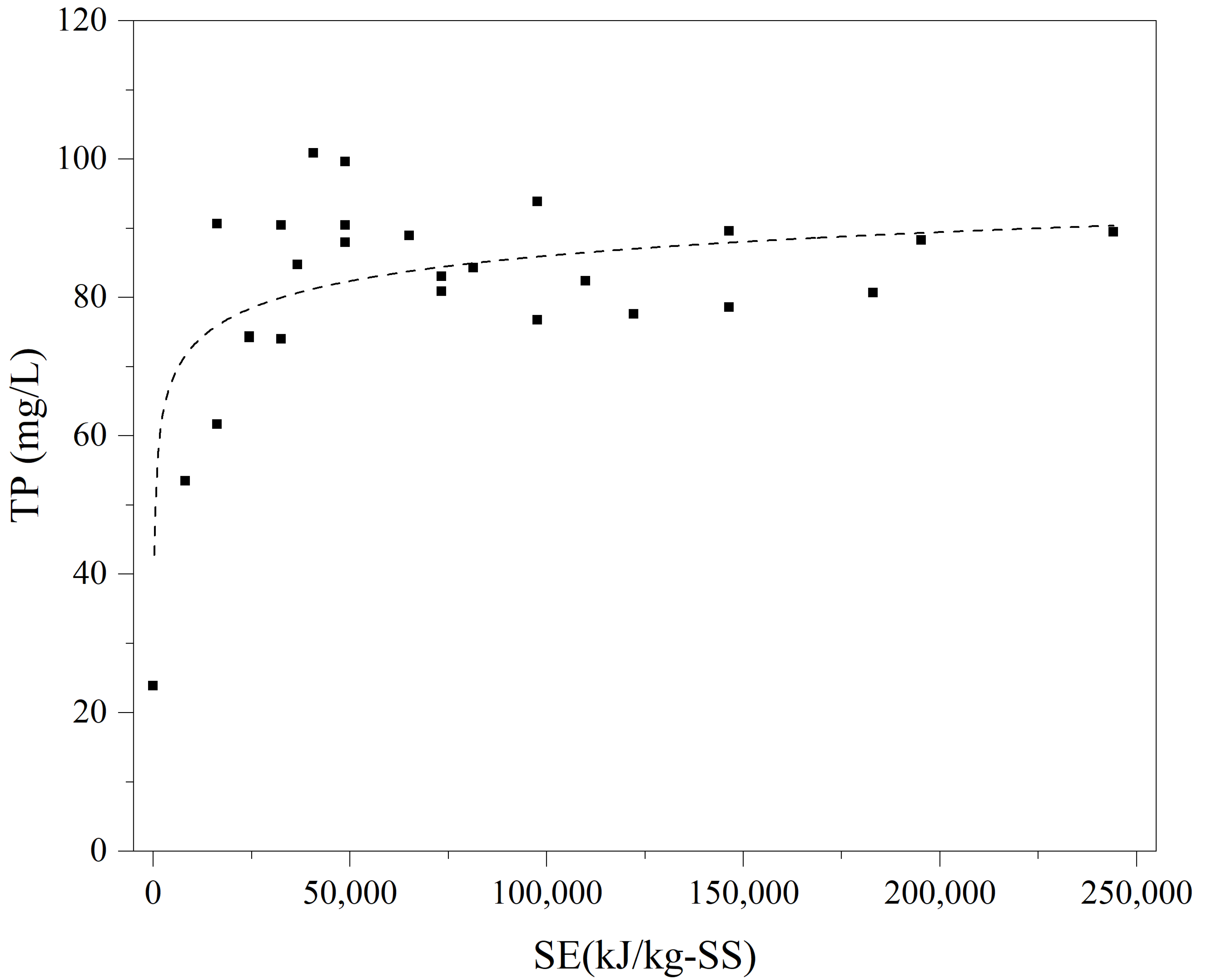
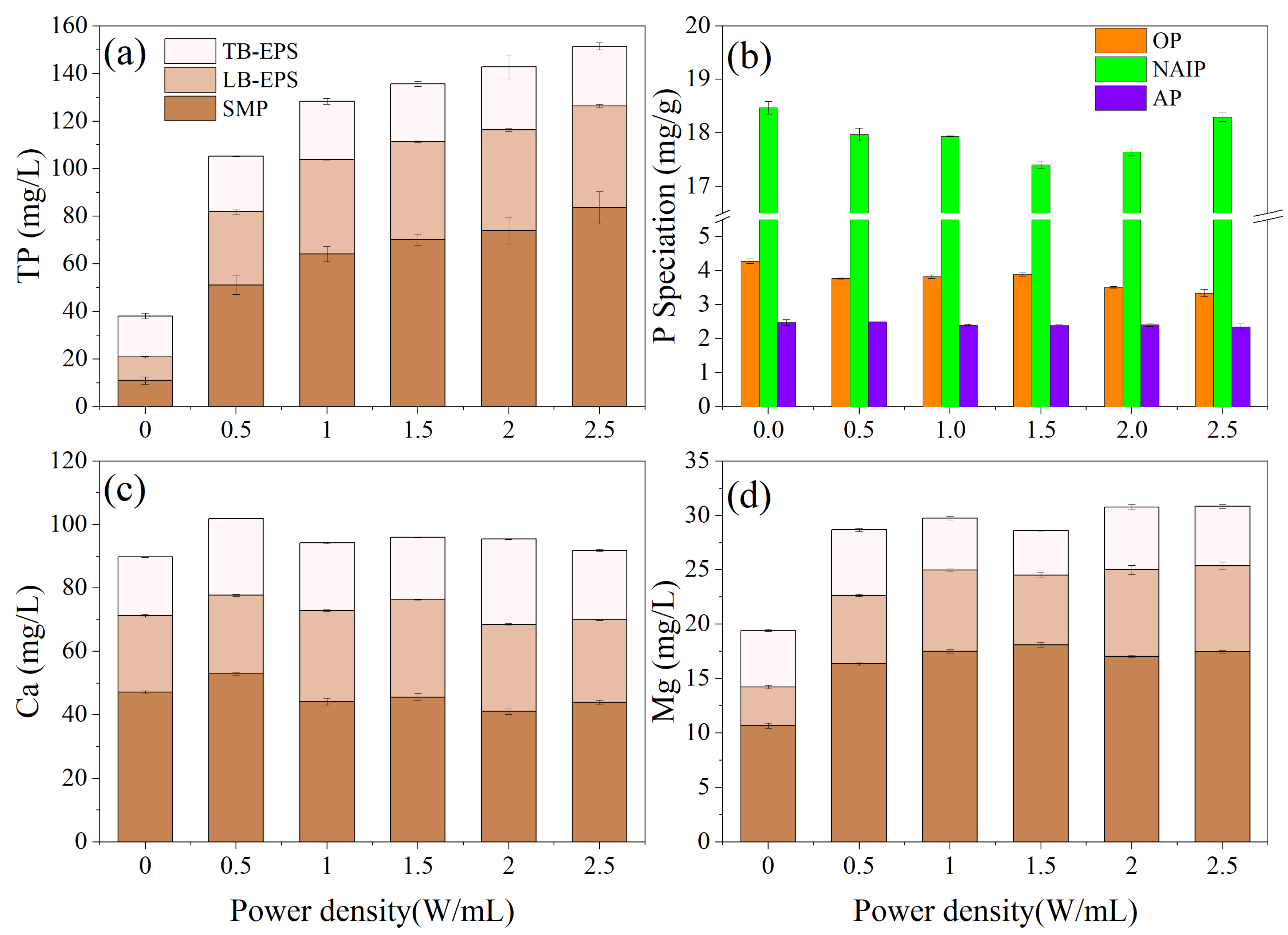


| Characteristics | SS | VSS | TCOD | TP | TN | pH | Al | Fe | Mg | Ca |
|---|---|---|---|---|---|---|---|---|---|---|
| Raw sludge | 35.4 g/L | 20.6 g/L | 11,857 mg/L | 834 mg/L | 964 mg/L | 6.45 | 53.05 mg/g | 5.02 mg/g | 3.38 mg/g | 11.04 mg/g |
Publisher’s Note: MDPI stays neutral with regard to jurisdictional claims in published maps and institutional affiliations. |
© 2022 by the authors. Licensee MDPI, Basel, Switzerland. This article is an open access article distributed under the terms and conditions of the Creative Commons Attribution (CC BY) license (https://creativecommons.org/licenses/by/4.0/).
Share and Cite
Yu, H.; Yang, Y.; Wu, X.; Yuan, W.; Wang, H.; Deng, H.; Sun, L.; Li, R. Phosphorus Migration and Transformation in Activated Sludge by Ultrasonic Treatment. Sustainability 2022, 14, 11224. https://doi.org/10.3390/su141811224
Yu H, Yang Y, Wu X, Yuan W, Wang H, Deng H, Sun L, Li R. Phosphorus Migration and Transformation in Activated Sludge by Ultrasonic Treatment. Sustainability. 2022; 14(18):11224. https://doi.org/10.3390/su141811224
Chicago/Turabian StyleYu, Huaixing, Yuhao Yang, Xueya Wu, Weifang Yuan, Hao Wang, Huanzhong Deng, Lianpeng Sun, and Ruohong Li. 2022. "Phosphorus Migration and Transformation in Activated Sludge by Ultrasonic Treatment" Sustainability 14, no. 18: 11224. https://doi.org/10.3390/su141811224
APA StyleYu, H., Yang, Y., Wu, X., Yuan, W., Wang, H., Deng, H., Sun, L., & Li, R. (2022). Phosphorus Migration and Transformation in Activated Sludge by Ultrasonic Treatment. Sustainability, 14(18), 11224. https://doi.org/10.3390/su141811224









